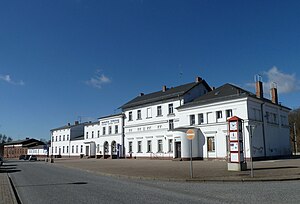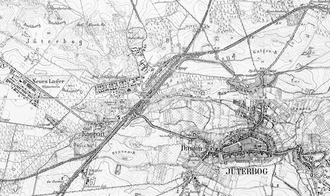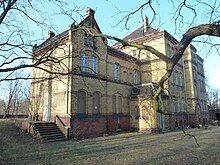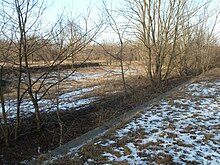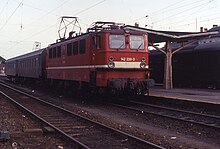Jueterbog train station
| Jueterbog | |
|---|---|
|
Entrance building, street side
|
|
| Data | |
| Location in the network | Separation station |
| Design | Through station |
| Platform tracks | 3 (formerly 7) |
| abbreviation | BJUE |
| IBNR | 8010182 |
| Price range | 5 |
| opening | July 1, 1841 |
| Profile on Bahnhof.de | Jueterbog |
| Architectural data | |
| Architectural style | classicism |
| location | |
| City / municipality | Jueterbog |
| Place / district | Jueterbog |
| country | Brandenburg |
| Country | Germany |
| Coordinates | 51 ° 59 '51 " N , 13 ° 3' 16" E |
| Railway lines | |
|
|
| Railway stations in Brandenburg | |
The Jüterbog train station in the town of the same name went into operation in 1841, making it one of the oldest train stations in today's state of Brandenburg. Since 1848 the Jüterbog – Röderau line has branched off from the main line of the Anhalter Bahn . With the opening of further railway lines, the importance of the station grew. Some of the routes have now been closed.
The station has lost its former importance in long-distance, freight and military traffic. Today it is used almost exclusively for regional traffic. The station building is a listed building. Also listed are the station building of the military railway , which was in operation for public transport until the end of the First World War , other buildings of the military railway and the water tower of the former depot northeast of the station.
Location and name
The station is located at 62.8 km on the Berlin – Halle line, counted from the former Anhalter Bahnhof in Berlin . The route runs in this area approximately from northeast to southwest. Also from the northeast, a little south of the direct line from Berlin, the now disused line from Zossen , the former military railway, reached the station. From the east, the narrow-gauge line from Dahme / Mark ran into the station. The route towards Falkenberg and Röderau branches off to the south from the route to Halle. The Jüterbog – Nauen railway begins on the opposite side and soon turns to the northwest.
The station is well outside the city center, about two kilometers west of the old town. Originally developed in an open field near the Kappan estate, urban development has now expanded to the train station. On the northwest side of the station is the Jüterbog II district, which was built on an old barracks site. At the southern end of the station, federal road 102 crosses under the railway facilities.
The station is built on a hillside. To the southeast, towards the city center, the site slopes down, while on the other side it rises to the former barracks area.
The station was named Jüterbog when it opened , and at times the city and station were also spelled Jüterbogk . Since the beginning of the 20th century, only today's spelling has been used.
history
The first years
As early as the mid-1830s, efforts were made to build a rail link from Berlin to Leipzig and Dresden . A number of variants for the route were discussed. In the end, a line was created from Berlin via Jüterbog, Wittenberg and Dessau to Köthen , where there was a connection to Magdeburg and Leipzig. In April 1839 the governments of Prussia and the Duchy of Anhalt concluded a corresponding state treaty, in the same month the Berlin-Anhaltische Eisenbahn-Gesellschaft (at that time still called Berlin-Sächsische Eisenbahn-Gesellschaft) adopted its company statute. Construction of the line began on April 15, 1839. After a good two years of construction, the Berlin - Jüterbog section and with it the Jüterbog train station went into operation on July 1, 1841. The Berlin-Anhaltische Eisenbahn-Gesellschaft (BAE) publicly announced the commissioning in newspapers that appeared on the opening day. Initially, three pairs of trains ran a day, which stopped between Berlin and Jüterbog in Trebbin and Luckenwalde . The gap between Jüterbog and Wittenberg was closed on September 10, 1841, completing the entire route. For the construction of the Jüterbog train station, 16,000 Reichstaler were estimated, in fact it cost 21,235 Taler. With the start of through traffic, two pairs of through trains drove between Berlin and Köthen via Jüterbog during the day.
At the same time there were considerations for the construction of a connection from Berlin to Dresden. Here, too, various routes were discussed until a connection from Jüterbog to Röderau, where there was a connection to the Leipzig – Dresden railway , turned out to be the cheapest option. BAE began construction of the branch line in May 1847, and the section between Jüterbog and Herzberg was completed by July 1, 1848 . On October 1st of the same year the extension to Röderau followed with the connecting curves in the direction of Leipzig and Dresden.
In the 1870s there were further considerations for an expansion of the route network. This included a route from Glöwen station on the Berlin-Hamburg railway via Brandenburg to Jüterbog, which was not implemented.
Jüterbog as a railway junction
In 1894 the line from Jüterbog to Treuenbrietzen went into operation, which was extended between 1904 and 1908 as part of a planned bypass line around Berlin via Potsdam to Nauen. In 1896 Jüterboger Straßenbahn AG opened a horse-drawn tram line from the train station to the city center, which was in operation until 1928.
Not least because of the good rail connections, the importance of Jüterbog as a military location grew. In 1890 the Imperial Artillery Shooting School began to move from Berlin to Jüterbog. They settled on the area adjacent to the north-west of the train station, where extensive barracks were built. In 1897 the Royal Prussian Military Railway extended its route from Berlin via Zossen from Kummersdorf to Jüterbog. The railway crossed the main line to the northeast of Jüterbog station and was given its own station on the side of the track system at the barracks facing away from the city.
On the other side of the main track opposite the military station, the Jüterbog-Luckenwalder Kreiskleinbahnen build the terminus of the narrow-gauge line from Dahme / Mark , which was opened in 1900.
At the beginning of the 20th century, the volume of traffic on the Anhalter Bahn increased significantly. For this reason, extensive work began after 1910 to expand the Anhalter Bahn. The section from Berlin to Jüterbog should be expanded to four tracks. In 1915 the work was already well advanced, but came to a standstill due to the First World War. A large number of relics of the extension buildings that were started at the time can still be seen. These include a dam northwest of the existing tracks in the area around Jüterbog train station, which was to accommodate the new long-distance tracks. At the same time, extensive structures were built south of the train station for the crossing-free extension of the routes to Röderau and Wittenberg. Extensions to the track systems in the northeastern station area were completed. After the First World War, the expansion plans were revived, but the work was finally stopped in 1922, not least because the Wiesenburg – Roßlau railway was another connection under construction between Berlin and Central Germany, which was supposed to relieve the Anhalter Bahn.
In the course of the Versailles Treaty , the military railroad from Berlin to Jüterbog had to be abandoned. The section from Zossen to Jüterbog remained in operation for civil use, but the trains have served the main railway station since then. The overpass over the tracks of the Anhalter Bahn was dismantled.
Development after 1945
As a result of the division of Germany and Berlin, the traffic flows changed. The route from Berlin via Jüterbog to Bitterfeld and on to Halle and Leipzig remained one of the most important routes in the GDR. Berlin could no longer be reached directly via the Anhalter Bahn, but from Ludwigsfelde via the Berlin outer ring .
After 1945, operations on the small railroad, which had been discontinued in 1932 for passenger and 1939 for freight, were resumed. One track was extended from the small station to the main line station. In 1963, the small train operation finally ended.
Many military installations in and around Jüterbog were used by the Soviet army after 1945. Accordingly, the station was also important for the Soviet Army. In addition to material transport, there were also military passenger trains. A separate reception building was built in the south-west of the station to handle passengers.
In 1974, the station received a new switchboard type GS III SP68, the first of its kind. It was on September 19, 1974 in operation, replacing three mechanical interlockings . It was housed in a striking structure on the northwest side of the track system. On May 27, 1979, the station was connected to the electrical contact line. Initially, the line to the southwest went into operation, followed on June 1, 1980 by the line towards Luckenwalde. In the following years, electrical operation was gradually started up to the Berlin outer ring and later further north. In September 1989 the section from Jüterbog to Falkenberg was electrified.
The Jüterbog train station in reunified Germany
After the turning point in the GDR and German reunification, the withdrawal of Soviet troops began, which was completed in 1994. After that, Jüterbog was no longer a military base. The importance of the station decreased accordingly, especially since freight traffic also fell sharply. The track systems of the station were dismantled to a considerable extent. In 1999 the tracks were connected to an electronic signal box . The track diagram signal box was thus superfluous, the building was completed in 2010.
In 1996, passenger traffic between Jüterbog and Sperenberg (two years later also on the entire route to Zossen) and goods traffic between Jüterbog and Zossen were suspended. The line was closed in the same year.
The station building was sold in 2015 to a private person who is thinking about usage concepts for the house. It is largely empty (as of 2016), and a ticket agency uses individual rooms in the building.
Investments
Reception building
The listed reception building is an elongated structure consisting of a central three-part original building from 1841 with extensions on both sides. The oldest, late Classicist middle section of the building is one of the oldest surviving train stations in the state of Brandenburg. It is a symmetrical system consisting of a three - axis, single - story middle section and two two-story side sections, each with five axes. All three parts have flat pitched gable roofs, the side parts risalit- like projections on the platform side.
The extension building from 1896 to the north-east is also in three parts with two two-story side segments consisting of three or five axes and an originally single-story five-axis middle section. Both side parts step forward to the station forecourt. The segment next to the old station building was used for the reception hall, in the middle segment there was the waiting room 1st and 2nd class (later used as a restaurant), in the northeast segment the waiting room 3rd and 4th class. The middle part of the extension building was increased in 1906 for an apartment for the Bahnhofswirt. The reception hall has two arched entrance and exit doors.
To the south-west of the original part of the station building there is a single-storey post-packing chamber built in 1874, which was added to in 1913.
In the monument topography, the building is recognized as one of the oldest preserved railway station buildings in the country and one of the few classicist buildings in the city. It shows the importance of the rail link for urban development.
Military station
Coordinates: 52 ° 0 '7.77 " N , 13 ° 3' 31.31" E
The military station is located northeast of the main line station on the side of the track facing away from the city. His reception building is a three-storey yellow brick building with a two-storey extension with a viewing gable on the track side and a staircase facing the forecourt.
Also listed are a toilet block, a one-story half-timbered building, as well as a two-story house made of red bricks and a warehouse and the goods shed made of yellow bricks. The design of the goods shed takes up the structural elements of the station building with plinths and ribbons made of red bricks.
The station building is used privately.
Platforms and tracks
Until the 1990s, the station had the following platforms:
- a house platform at the station building
- two central platforms northwest of the house platform, each with two platform edges
- a platform east of the main platform wedge-shaped to this arranged on a track ending in the station forecourt, mainly used for trains in the direction of Zossen.
- a platform in the southwestern extension of the house platform. This was also used for public passenger trains, but also served passenger trains for the Soviet Army. A separate reception building for the Soviet army was built on it in the 1950s. It is located on the street well below the ground level of the railway and was thus given an exit to the platform on the upper floor.
To the northeast of the platforms in the direction of Berlin are the once extensive facilities for freight traffic and operational tasks. In addition to the loading street there, the station had other separate loading points:
- Loading point I on the northeast edge of the train station (Neuheimer Weg)
- Loading point II in the former military station
- Loading point III on the station forecourt
Most of the facilities have now been dismantled. The main platform, mainly used by the trains going to Berlin, and an island platform, mainly for the trains going to Wittenberg and Falkenberg and Berlin-Wannsee via Treuenbrietzen, are still in operation. To the northeast of it there are still some operational tracks.
The platforms are connected by a pedestrian tunnel, which also opens up the areas of the Jüterbog II district to the northwest of the station. A footbridge leads about 500 meters northeast of the platforms at the level of the military station over the tracks.
Depot
Coordinates: 52 ° 0 ′ 21.85 ″ N , 13 ° 4 ′ 3.5 ″ E
The depot in the branching of the lines to Berlin and Zossen was created at the beginning of the 20th century in the course of Jüterbog's development into a railway junction. Before that, Jüterbog was just a train station . Jüterbog was briefly run as an independent service center around 1909, but it was not until 1924 that it received the status of an independent railway depot. After 1990 the depot lost its importance, in 1994 it was converted into an operation site for the Seddin depot and has been completely unused since 1998.
In the western part of the factory premises is the listed water tower, built between 1915 and 1917. It is a building made of red bricks, which tapers towards the top, with a container room made of brick-lined iron framework. The technical equipment was retained even after it was no longer used as a water tower. The monument topography honors it as one of the few preserved technical monuments in Jüterbog.
The monument topography also mentions the ten-hour roundhouse from 1914 and an administration building from the 1950s. However, these buildings were not on the country's list of monuments. In an unauthorized demolition operation, the depot buildings, which had previously been vacant for a long time, with the exception of the water tower, were demolished in 2016.
passenger traffic
railroad
Long-distance trains stopped at Jüterbog station until the end of the 1990s. However, for a number of decades, from the end of the 19th century to the beginning of the 1990s, only a part of the many express trains on the route stayed in the station. There were also passenger trains, including on the branch lines. A special feature in GDR times was a passenger train from Jüterbog via Zossen and Erkner to Frankfurt (Oder), which was released for public transport in GDR territory. This train only carried direct carriages into the Soviet Union that could be used by members of the Soviet armed forces.
At the beginning of the 1990s, the train ticket was clocked.
In 1995 the station was served by the following lines:
| line | Line course | Cycle (min) |
|---|---|---|
| IR | ( Stralsund -) Berlin-Lichtenberg - Jüterbog - Halle (Saale) - Frankfurt (Main) main station | 120 |
| RE 3 | ( Stralsund -) Berlin-Lichtenberg - Jüterbog - Falkenberg (Elster) - Ruhland - Cottbus | 120 |
| RB 31 | Schönefeld Airport - Zossen - Jüterbog | 120 |
| RB 33 | Potsdam city - Beelitz city - Jüterbog | 120 |
| RB | Jüterbog - Lutherstadt Wittenberg - Halle (Saale) | 120 |
In 1996 the traffic to Zossen was stopped, in 1999 the interregional trains were relocated on the Dessau – Berlin route. Instead, an intercity line ran via Lutherstadt Wittenberg to Berlin, but it did not stop in Jüterbog. For one year there was still a pair of interregional trains from Berlin with a stop in Jüterbog to Oberstdorf , which was discontinued in 2000. Since then, no long-distance trains have stopped at Jüterbog station. Instead, the regional train offer has been increased, since 1999 the RE trains between Berlin and Jüterbog have been running every hour, with the connections changing several times over the years. Since 2006, Jüterbog has been directly connected to Berlin city center again via the Anhalter Bahn, the detour via Schönefeld is no longer necessary. In the 2018/19 timetable, the following lines serve the station:
| line | Line course | Cycle (min) |
|---|---|---|
| RE 3 | Schwedt (Oder) / Stralsund - Eberswalde Central Station - Berlin - Jüterbog - Lutherstadt Wittenberg / Falkenberg (Elster) |
60 Angermünde - Jüterbog 120 remaining sections |
| RE 4 | Jüterbog - Luckenwalde - Ludwigsfelde - Berlin - Wustermark - Rathenow | individual trains |
| RB 33 | Jüterbog - Treuenbrietzen - Beelitz City - Michendorf - Berlin-Wannsee |
60 (Mon-Fri) 120 (Sat-Sun) |
| S 2 / S 8 | Jüterbog - Zahna - Lutherstadt Wittenberg - Graefenhainichen - Bitterfeld - Leipzig / Halle | individual trains |
Other means of transport
Bus lines connect the train station with the bus station in the city center and with Treuenbrietzen .
Jüterbog station is the starting point for trips on the Flaeming skate , which runs a few hundred meters north of the station. The Berlin – Leipzig cycle route also runs there . The Brandenburg Tour and two of the Brandenburg City Center cycle routes run on the south-east side of the train station.
Web links
- Entry in the monument database of the State of Brandenburg
- Tracks in service facilities (BJUE) , DB Netz AG (PDF; track plan)
Individual evidence
- ^ Peter Bley: 150 Years of the Berlin-Anhalt Railway . alba, Düsseldorf 1990, ISBN 3-87094-340-8 , pp. 14-17.
- ^ Peter Bley: 150 Years of the Berlin-Anhalt Railway . alba, Düsseldorf 1990, ISBN 3-87094-340-8 , pp. 24-26.
- ^ Peter Bley: 150 Years of the Berlin-Anhalt Railway . alba, Düsseldorf 1990, ISBN 3-87094-340-8 , p. 34.
- ^ Peter Bley: 150 Years of the Berlin-Anhalt Railway . alba, Düsseldorf 1990, ISBN 3-87094-340-8 , pp. 36-38.
- ^ Peter Bley: 150 Years of the Berlin-Anhalt Railway . alba, Düsseldorf 1990, ISBN 3-87094-340-8 , p. 44.
- ^ Peter Bley: 150 Years of the Berlin-Anhalt Railway . alba, Düsseldorf 1990, ISBN 3-87094-340-8 , p. 107.
- ^ Peter Bley: 150 Years of the Berlin-Anhalt Railway . alba, Düsseldorf 1990, ISBN 3-87094-340-8 , p. 109.
- ^ Railway facilities in and around Berlin BiuuB, Military Railway Berlin - Jüterbog Introduction. In: biuub.de. October 7, 1903, Retrieved February 17, 2019 .
- ↑ Jüterboger welcome the district meeting at the train station. In: Märkische Allgemeine Zeitung , April 16, 2016, online .
- ↑ a b c d Monument topography Federal Republic of Germany - Monuments in Brandenburg. Volume 17.1: Teltow-Fläming district. Part 1: City of Jüterbog with Zinna Monastery and Niedergörsdorf community. , Edited by Marie-Luise Buchinger, Marcus Cante et al., Wernersche Verlagsgesellschaft, Worms 2000, ISBN 3-88462-154-8 , p. 179.
- ↑ Monument topography Federal Republic of Germany - Monuments in Brandenburg. Volume 17.1: Teltow-Fläming district. Part 1: City of Jüterbog with Zinna Monastery and Niedergörsdorf community. , Edited by Marie-Luise Buchinger, Marcus Cante et al., Wernersche Verlagsgesellschaft, Worms 2000, ISBN 3-88462-154-8 , p. 228.
- ↑ Klaus-Jürgen Kühne: Bahnbetriebswerke der GDR , transpress Verlag , Stuttgart 2011, ISBN 978-3-613-71401-4 , p. 32.
- ↑ Monument topography Federal Republic of Germany - Monuments in Brandenburg. Volume 17.1: Teltow-Fläming district. Part 1: City of Jüterbog with Zinna Monastery and Niedergörsdorf community. , Edited by Marie-Luise Buchinger, Marcus Cante et al., Wernersche Verlagsgesellschaft, Worms 2000, ISBN 3-88462-154-8 , p. 198.
- ↑ Jüterbog Railway Works is in ruins . In: Märkische Allgemeine Zeitung , May 24, 2016, online .
